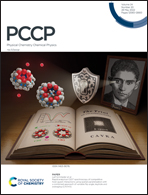Core-electron contributions to the molecular magnetic response†
Abstract
Orbital contributions to the magnetic response depend on the method used to compute them. Here, we show that dissecting nuclear magnetic shielding tensors using natural localized molecular orbitals (NLMOs) leads to anomalous core contributions. The arbitrariness of the assignment might significantly affect the interpretation of the magnetic response of nonplanar molecules such as C60 or [14]helicene and the assessment of their aromatic character. We solve this problem by computing the core- and σ-components of the induced magnetic field (and NICS) and the magnetically induced current density by removing the valence electrons (RVE). We estimate the core contributions to the magnetic response by performing calculations on the corresponding highly charged molecules, such as C6H630+ for benzene, using gauge-including atomic orbitals and canonical molecular orbitals (CMOs). The orbital contributions to nuclear magnetic shielding tensors are usually estimated by employing a natural chemical shielding (NCS) analysis in NLMO or CMO bases. The RVE approach shows that the core contribution to the magnetic response is small and localized at the nuclei, contrary to what NCS calculations suggest. This may lead to a completely incorrect interpretation of the magnetic σ-orbital response of nonplanar structures, which may play a major role in the overall magnetic shielding of the system. The RVE approach is thus a simple and inexpensive way to determine the magnetic response of the core- and σ-electrons.

- This article is part of the themed collection: 2022 PCCP HOT Articles


 Please wait while we load your content...
Please wait while we load your content...